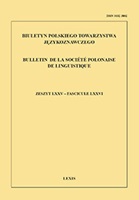Linguistica generale czyli o obecności terminologii językoznawczej w opisie dzieł sztuk wizualnych i architektury
Linguistica generale: linguistic terminology in the description of visual artworks and architecture
Author(s): Elżbieta Chrzanowska-KluczewskaSubject(s): Architecture, Visual Arts, Sociolinguistics, Sociology of Art, Stylistics
Published by: Polskie Towarzystwo Językoznawcze
Keywords: linguistica generale; linguistic terminology; the visual arts; architecture; metaphorical vs; systematic terms; metalanguage; transmediality;
Summary/Abstract: Contemporary linguistics, for years drawing its terminology from other fields of study, in the 20th century became a donor of its own terms for the purpose of describing the visual arts. An important stimulus for this trend came from Benedetto Croce (1902), who postulated linguistica generale as a common platform for the philosophy of language and aesthetics. In the opinion of art historian Jan Białostocki (1980/2009), it was not only Croce’s treatise but also European structuralism (Roman Jakobson, Roland Barthes) that contributed to the intrusion of linguistic terms into the theory of art, leading to a “paralinguistic version” of semiotic studies in the area of aesthetics. In turn, Mieczysław Porębski (1986/2009), an art critic and semiologist, called it a “semiotic attitude” to art, engaging himself in a prolonged debate on the possibility of approaching visual texts in a “pro-linguistic” manner. The following article gives a concise and very selective presentation of advocates of the semiotic (mainly linguistic) approach to analysing visual artworks and architecture. The researchers listed represent various schools and traditions: a) semiotics/structuralism, b) philosophy of art, philosophy of language and formal logic, c) a rhetorical-figurative approach (with its roots in the theories of Barthes and Jurij Lotman, among others), including also a different paradigm of cognitive linguistics and multimodal tropology in particular, d) the Scandinavian school of pictorial semiotics (Göran Sonesson), and – finally – e) social semiotics with its grammar and modality of visual representations, related to various theories of communication. Next, the article poses the question about the status of terminological borrowings from linguistics and the related fields present in theoretical considerations on the visual arts and architecture, dividing them into three classes: 1) metaphorical non-systematic terms (architectural ekphrasis, architectural poetics of Madeline Gins and Arakawa), 2) terminological adaptations, that is partly metaphorical systematic terms (Gunther Kress and Theo van Leeuwen’s grammar of visual design), and 3) metaphorical systematic terms (tropology in visual cognitive poetics and multimodal studies; Andrzej Niezabitowski on their application to a new subdiscipline of architecture, viz. architectonics). A related issue is the status of natural language as a metalanguage in the description of other semiotic systems (Croce, Heinrich Wölfflin, Ludwig Wittgenstein, Emil Benveniste, Lotman, Mark Johnson). The author of this article assumes a semiotic stance, perceiving the presence of linguistic terms across the theory of art and architecture as a proof of transmediality of verbal and visual texts within the Lotmanian semiosphere This calls for development of a broad methodological platform for their comprehensive study, postulated as well by Alina Kwiatkowska (2013) within cognitive studies on visual perception and multimodality.
Journal: Biuletyn Polskiego Towarzystwa Językoznawczego
- Issue Year: LXXVI/2020
- Issue No: 76
- Page Range: 51-69
- Page Count: 19
- Language: Polish

